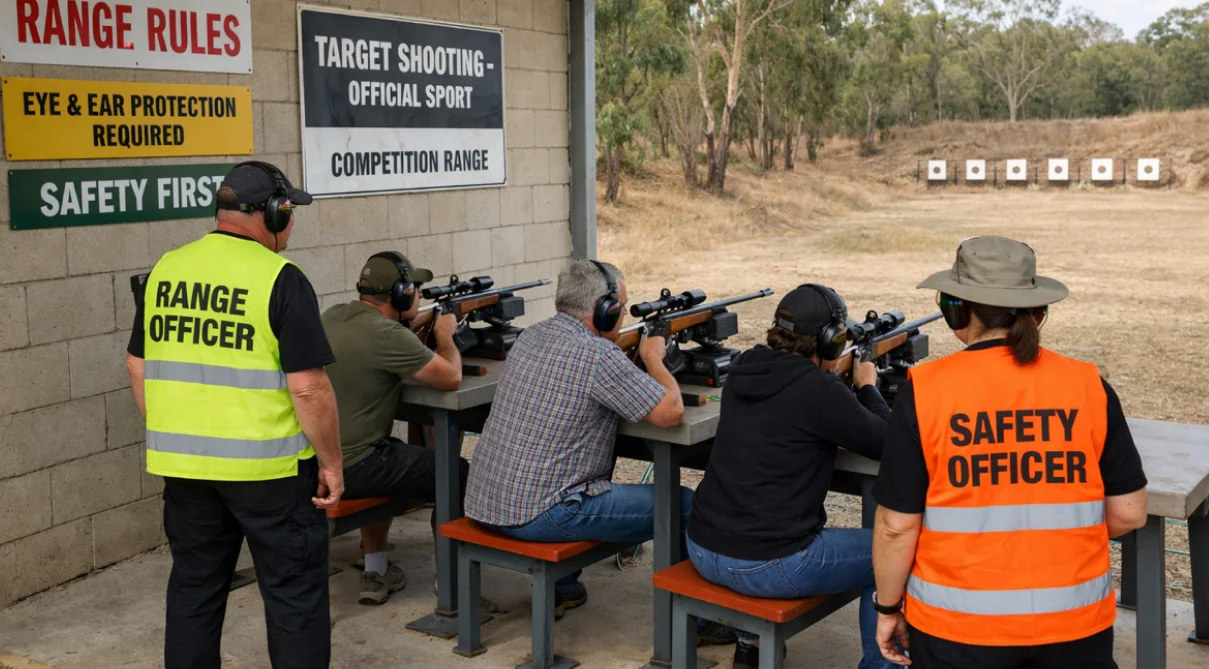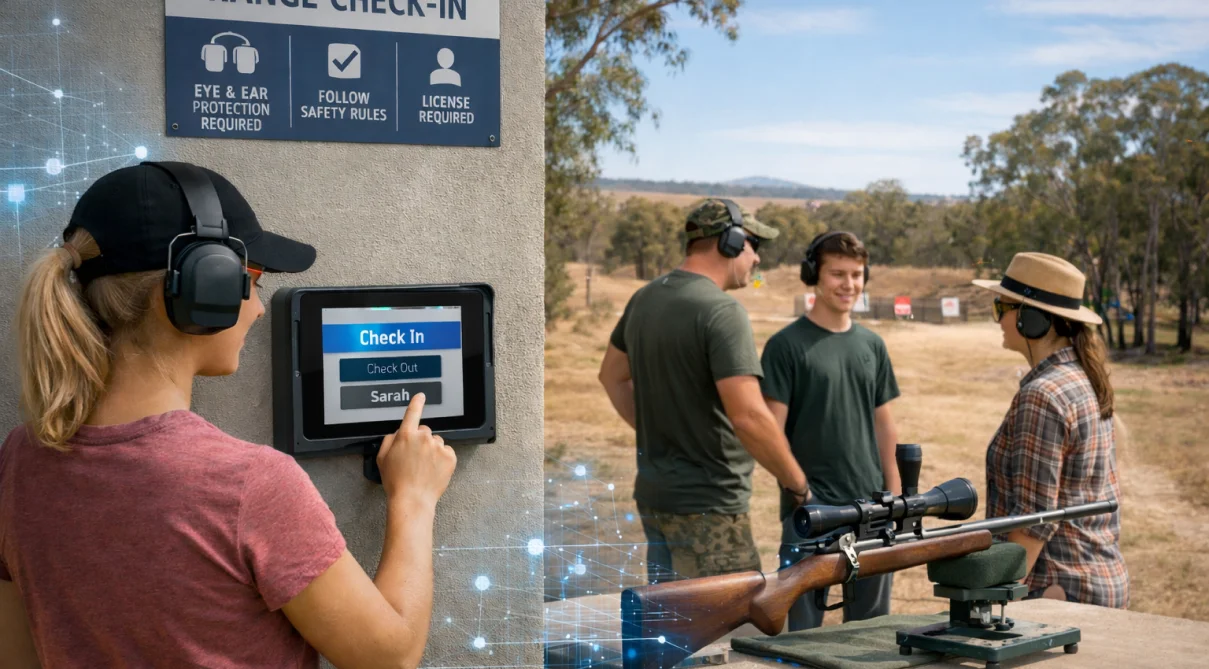Digital Check-In Solutions for Shooting Clubs for Attendance and Score tracking
Digital Check-In is a system designed to streamline efficiency and experience.


In an era where digital solutions have transformed industries, shooting clubs and ranges are no exception. Running a shooting club involves not only the art of the sport but also the logistics of managing members, recording scores, tracking attendance, and ensuring compliance with safety regulations. Historically, many clubs have relied on manual processes—paper sign-ins, attendance sheets, and manual score tracking. While these methods get the job done, they’re prone to error, slow to update, and often a burden for administrators.
Enter Digital Check-In—a system designed to streamline these processes, improving the efficiency and experience for both members and staff alike. Installed on a tablet at the club, digital check-ins offer real-time data tracking, seamless score integration, and easier compliance management. Let’s explore the benefits of switching to a digital system, both for shooting clubs and the shooting sports industry.
The General Benefits of Digital Check-In for Clubs and Ranges
Streamlined Operations
For many clubs, the traditional member check-in process is tedious. Paper forms and manual sign-ins can slow down the entry process, leading to lines at busy times and errors in record-keeping. A digital check-in system eliminates these bottlenecks by allowing members to quickly sign in using a simple interface on a tablet or kiosk at the club. Members select their activity and immediately start their session.
With digital records, club administrators can access data instantly, freeing them from the time-consuming task of manually entering or sorting through attendance sheets. This not only speeds up operations but also makes managing multiple members and events much easier.
Improved Member Experience
Today’s members expect seamless digital experiences in all aspects of their lives, and shooting clubs should be no different. With Digital Check-In, members don’t need to worry about waiting in line, filling out forms, or handing in paper logs. Instead, they can quickly check in, select their activity, and get started with their session. This fast, modernised process improves overall member satisfaction.
Additionally, when the check-in is automated, there’s less chance of errors that could affect attendance or match score logging. This means less frustration for members, who can focus on the activities they enjoy rather than administrative formalities.
Real-Time Data Access
One of the biggest advantages of digital check-in systems is the ability to access data in real-time. Administrators can instantly see who is on-site, what activities are happening, and what scores have been recorded. This provides greater oversight and control, allowing clubs to manage their daily operations more effectively.
For example, during competitions or matches, club officials can easily pull up live attendance reports or monitor which members have checked in for specific activities. This level of transparency improves overall management and enhances decision-making.
Eliminating Paper Records
Gone are the days of manually filing paperwork and keeping track of attendance sheets. With Digital Check-In, the need for paper logs is eliminated, creating an eco-friendly, streamlined approach to record-keeping. All data is stored digitally in the cloud, making it accessible at any time without the risk of losing or damaging physical records.
This move away from paper also brings a more professional atmosphere to the club. When members see digital solutions in place, they perceive the club as forward-thinking and organised, which can contribute to higher membership retention and satisfaction.
Specific Benefits for Shooting Clubs and Ranges
Attendance Reporting for Compliance
Shooting clubs must adhere to strict regulatory requirements, and one of the key aspects of compliance is ensuring that member attendance is accurately tracked. Many clubs, especially those affiliated with organisations like the Sporting Shooters’ Association of Australia (SSAA), require a certain number of recorded sessions to maintain memberships or certifications.
With Digital Check-In, compliance is simplified. Attendance is automatically logged when members check in, ensuring there are no discrepancies or missed records. These digital logs are easy to access and audit, providing club administrators with a clear and accurate record of participation.
Integrated Score Tracking
A major advantage of Digital Check-In systems is the ability to integrate with score tracking systems. After checking in, members can participate in matches or activities, and their scores are automatically linked to their attendance record. For competitions and events, this ensures that only valid participants’ scores are recorded.
Members can also submit their scores after completing activities. Clubs can choose to have scores automatically validated or manually approved by an administrator. This process ensures transparency and accuracy in scorekeeping, which is essential for competition fairness and regulatory compliance.
Activity Selection and Participation Logs
Another key feature of Digital Check-In is the ability to log member participation in specific activities. When members check in, they can select which event or session they are participating in, such as practice rounds, training sessions, or official competitions. This data is logged and tracked in real time, allowing clubs to maintain detailed participation records.
For administrators, this means they have complete visibility into which activities are most popular, which members are attending specific sessions, and how overall participation trends are evolving. These insights are invaluable for event planning and scheduling.
Ensuring Validity for Performance-Based Activities
Many shooting activities, particularly competitions or matches, require valid scores for attendance to be counted toward qualifications or rankings. With Digital Check-In, the system ensures that members’ attendance is only validated once a valid score has been submitted. This feature guarantees that the club maintains high standards for performance-based activities while reducing the risk of fraudulent score submissions.
This validation process is essential for clubs that need to adhere to specific qualification criteria. It ensures that only members who have actively participated in and completed their activities have their attendance counted.
Why Tablets and Web-Based Check-in is Ideal for Shooting Clubs
Ease of Installation and Use
One of the most appealing aspects of digital check-in systems is their simplicity. A tablet-based solution is easy to install and can be set up with minimal hardware. Because the system is web-based, there’s no need to worry about software installation or specialised equipment. All that’s required is a tablet, which serves as a self-check-in kiosk for members.
Clubs that have multiple locations or outdoor facilities can easily place these kiosks in convenient areas, making it simple for members to sign in upon arrival.
Portability and Durability
Tablets are portable, lightweight, and can be stationed at any convenient check-in point at the club. Whether members are checking in for an indoor session or an outdoor match, the tablet-based system can adapt to the environment. Additionally, most tablets are durable enough to handle frequent use, and protective cases or mounts can further increase their longevity.
Cloud-Based Data Storage
With a web-based digital check-in system, all data is stored securely in the cloud. This means that member check-ins, attendance logs, and score submissions are backed up in real-time, ensuring that no data is lost. If a device is damaged or lost, the data remains safe and accessible from any other device with internet access.
This also means that club administrators can access the system remotely, making it easy to track attendance or review score submissions from anywhere.
Integration with Other Club Management Systems
Many digital check-in systems integrate with other management tools, such as membership databases, event management platforms, and financial reporting software. This creates a seamless, unified system for club management, where all administrative tasks can be handled from one central platform.
For example, once a member checks in and completes an activity, their attendance and scores can automatically sync with their membership records, ensuring that all relevant data is up-to-date.
How Digital Check-In Enhances Member Accountability
Accurate Member Records
When members check in digitally, their attendance is logged automatically, creating a precise record of their participation. There’s no need for manual entry or reconciliation with paper logs, which reduces the chance of errors. This accountability ensures that each member’s participation is accurately tracked and recorded.
Self-Reported Scores
With Digital Check-In, members can submit their scores after participating in an activity. The club then has the option to manually or automatically validate these scores, ensuring they meet the required standards. This level of accountability is crucial for competitive settings where accurate scorekeeping is essential.
Automated Reminders and Notifications
Digital check-in systems can be configured to send automated reminders or notifications to members who haven’t completed their score submissions or attendance requirements. This ensures that members stay on track with their participation and comply with club policies without relying on manual follow-ups from administrators.
Security and Data Privacy
Secured Digital Logs
One of the primary concerns with paper-based systems is the risk of lost or tampered records. With Digital Check-In, all data is encrypted and stored securely, ensuring that it is protected from unauthorized access. This added layer of security ensures that member information and attendance records are kept confidential.
Controlled Access and Data Validation
Administrators can control who has access to certain data. For instance, only authorised personnel can validate scores or modify attendance records, while other users may only have viewing rights. This system of controlled access ensures that sensitive data remains protected and can only be edited by trusted staff members.
Boosting Club Efficiency with Digital Check-In
Reduced Administrative Work
With Digital Check-In, attendance is logged automatically, scores are tracked in real-time, and compliance reporting is simplified. This reduces the burden on club administrators, who no longer need to manually compile data or reconcile attendance and score sheets. Automating these tasks frees up valuable time, allowing staff to focus on improving club operations, planning events, or engaging with members directly.
Better Insights for Club Growth
The data collected from digital check-ins offers valuable insights into how your club is performing. Administrators can analyse attendance patterns, score trends, and activity preferences to make informed decisions about future events and club activities. For example, if data shows a particular shooting discipline is more popular, the club can organise more sessions of that type to increase member engagement.
These insights are not only helpful for improving the current experience but also critical for planning long-term growth strategies. Clubs can monitor which days or times are busiest, see which members are most active, and identify areas where improvements can be made.
Immediate Access to Performance Data
Digital systems allow administrators to review performance data immediately after events or activities. Whether it’s validating scores or checking who attended a specific session, all information is available in real-time. This transparency allows for better event management and provides a clear overview of how individual members are progressing. Clubs can track members’ performance over time, ensuring they meet required qualifications or are recognised for their achievements.
This real-time availability of data is particularly important during competitions or tournaments, where quick access to results and attendance can be crucial for determining standings or awarding prizes.
The Future of Shooting Club Management
Digital Check-In is revolutionising the way shooting clubs operate. It offers a host of benefits, from streamlining attendance reporting to simplifying score tracking and improving member accountability. By eliminating the need for paper records and manual data entry, digital systems improve both the efficiency and accuracy of club operations.
With the ability to integrate score tracking, validate attendance, and provide real-time data, digital check-ins allow club administrators to focus more on enhancing the shooting experience for members. Whether it’s ensuring compliance, tracking participation, or gaining valuable insights for future planning, digital systems make managing shooting clubs more effective and scalable.
By adopting a tablet-based, web-integrated solution like Squadspot’s Digital Check-In, shooting clubs can modernise their operations and provide a better experience for both staff and members. In a world where digital transformation is critical to remaining competitive, it’s time for shooting clubs to take advantage of these tools and elevate their management capabilities.




